In an unprecedented finding, NASA’s Chandra X-Ray Observatory uncovered a “treasure trove” of ancient black holes — over 5,000 of them. This psychedelic new image shows X-rays radiating mainly from primordial supermassive black holes in the hearts of galaxies that are billions of years old, and may even date back to the beginning of the universe.
It may look like nothing more than a pretty space picture, perhaps containing many stars, but there’s more much to it. Chandra stared at the same patch of sky for several weeks to collect a mass of weak X-Ray photons, that traveled billions of light-years to reach Chandra’s eyes. This photo is essentially Chandra’s version of the Hubble Deep Field image — the historic image that revealed hundreds of galaxy in a seemingly empty patch of space. And just like Hubble, Chandra did not disappoint — the observatory discovered thousands of never-before-seen supermassive black holes.
Chandra stared into an empty patch of sky and discovered over 5,000 new black holes.
“It can be very difficult to detect black holes in the early universe because they are so far away and they only produce radiation if they’re actively pulling in matter,” explained Bin Luo, of Nanjing University in China, who helped in the discovery. “But by staring long enough with Chandra, we can find and study large numbers of growing black holes, some of which appear not long after the Big Bang.”
So far, astronomers have been able to determine the age of the black holes by measuring the distance to each of the dots. They’ve also observed that black holes grew roughly two billion years after the Big Bang, and those in the early universe didn’t grow due to a steady diet, they seemed to go through random and dramatic growth spurts.
Black holes are still a mystery as astronomers know these cosmic behemoths lurk in the center of most galaxies, they don’t really know how they grow so massive. The team is hopeful this discovery will help astronomers better understand how the most monstrous black holes in our universe formed and grew to be so large.
